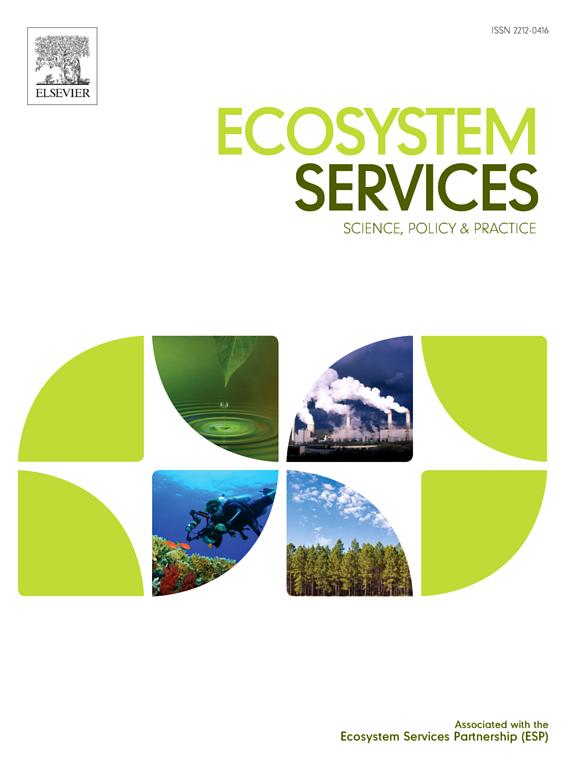评估和核算与水有关的生态系统服务的水价和管理:一个澳大利亚的案例研究
IF 6.6
2区 环境科学与生态学
Q1 ECOLOGY
引用次数: 0
摘要
通过展示生态系统服务(ES)的价值,生态系统会计通过从供需角度提供见解来解决水危机。这需要对生态系统价值进行评估,并了解评估方法、会计处理和水资源供应如何影响生态系统价值。使用环境经济会计系统(SEEA),我们使用多种方法、两种会计处理对与水相关的生态系统进行了评估,并为澳大利亚首都地区(ACT)制作了货币生态系统账户,以评估会计如何支持水价和管理。我们发现ES值在评估方法、会计处理和水资源可用性方面存在显著差异,在澳大利亚首都地区从- 10澳元到9.98亿澳元不等。巨大的范围突出了在使用SEEA时选择适当方法和会计处理的重要性。我们对ES估值的方法是:(1)ES价值嵌入在经济交易中,ES价值是这些交易的一个子集,(2)ES价值在经济交易中未被确认,并使用代理方法。使用第二种方法,使用类似市场的价格和重置成本的方法扩大了国民核算体系的生产边界,并提供了关于经济价值的额外资料。利用ACT数据,我们展示了如何将生态系统估值和会计应用于当前的水价,以更好地反映生态系统的使用、水资源短缺以及分摊成本。考虑到ES价值,可以证明价格上涨是合理的,以限制短期需求,并为集水区管理活动(“基于自然的解决方案”)以及供水基础设施提供资金。总之,这些工具和行动可以减轻在社会生态约束下可持续满足水需求的挑战。本文章由计算机程序翻译,如有差异,请以英文原文为准。
Valuing and accounting for water-related ecosystem services for water pricing and management: An Australian case study
By demonstrating the value of ecosystem services (ES), ecosystem accounting addresses the water crises by providing insights from both supply and demand perspectives. This requires ES valuation and an understanding of how valuation methods, accounting treatments, and water availability affect ES values. Using the System of Environmental-Economic Accounting (SEEA), we valued water-related ES using multiple methods, two accounting treatments, and produced monetary ES accounts for the Australian Capital Territory (ACT) to evaluate how accounting can support water pricing and management. We found that ES values varied significantly across valuation methods, accounting treatments, and water availability, ranging from AUD −10 to 998 million in the ACT. The huge range highlights the importance of selecting appropriate methods and accounting treatments when using the SEEA. Our approaches to ES valuation were: (1) ES value is embedded within economic transactions and ES value is a subset of these, and (2) ES value is unrecognised in economic transactions and proxy methods are used. Using the second approach, methods that use prices from similar markets and replacement cost extend the production boundary of the System of National Accounts (SNA) and provide additional information on economic value. Using ACT data, we demonstrate how ES valuation and accounting can be applied to current water pricing to better reflect ES use, water scarcity, and to spread costs overtime. Accounting for ES value may justify price increases to limit short-term demand, and fund catchment management activities (‘nature-based solutions’) as well as water supply infrastructure. Together, these tools and actions can mitigate the challenges of sustainably meeting water demands within socio-ecological constraints.
求助全文
通过发布文献求助,成功后即可免费获取论文全文。
去求助
来源期刊

Ecosystem Services
ECOLOGYENVIRONMENTAL SCIENCES&-ENVIRONMENTAL SCIENCES
CiteScore
14.90
自引率
7.90%
发文量
109
期刊介绍:
Ecosystem Services is an international, interdisciplinary journal that is associated with the Ecosystem Services Partnership (ESP). The journal is dedicated to exploring the science, policy, and practice related to ecosystem services, which are the various ways in which ecosystems contribute to human well-being, both directly and indirectly.
Ecosystem Services contributes to the broader goal of ensuring that the benefits of ecosystems are recognized, valued, and sustainably managed for the well-being of current and future generations. The journal serves as a platform for scholars, practitioners, policymakers, and other stakeholders to share their findings and insights, fostering collaboration and innovation in the field of ecosystem services.
 求助内容:
求助内容: 应助结果提醒方式:
应助结果提醒方式:


